Final report for OW16-028
Project Information
The purpose of this project was to examine potential benefits of cover crops for mature hazelnut orchards in the Willamette Valley, Oregon where 99% of the US hazelnut crop is produced. Summers are dry but winters are characterized by intense precipitation and are very wet (40-50 in precipitation annually). Currently, maintenance of a bare orchard floor is the common practice to facilitate efficient mechanical harvest of nuts from the orchard floor where the nuts drop naturally when they are mature. Erosion and nutrient leaching are major concerns during the wet winter season in bare ground orchards with any kind of slope. Harvesting from the bare soil surface under wet conditions can be very problematic, and while growers try to avoid this scenario, at times they are forced to harvest under inclement weather when the alternative is to lose the crop to defects like mold. Mechanical harvest on wet ground causes damage to the orchard floor and a results in dirty crop, and increased cleaning fees from the nut receiving station where the product is washed and dried. Nut quality and economic returns decline rapidly as the crop rests on wet ground. Maintaining permanent cover crops that are compatible with harvest has potential to improve economic returns for hazelnut growers by mitigating the uptake of contaminants into harvesters, improving drainage of surface water, providing a drier vegetative surface for the nuts to rest on (may reduce mold defects), and allowing equipment to access orchards that would otherwise be too slippery to harvest. Cover crops that can be seeded or regenerated from a spring seeding after being terminated for harvest from a bare orchard floor to protect soil during winter also have value. This project also explored potential for N-fixing cover crops to not only mitigate erosion, but also provide nitrogen to the hazelnut trees. Finding affordable off-farm sources of N for organic growers can be prohibitive and use of N-fixing cover crops could provide a less expensive, more sustainable source of N. Food safety concerns for a crop that is harvested from the ground limit feasibility of using cheap off-farm sources of N such as manures.
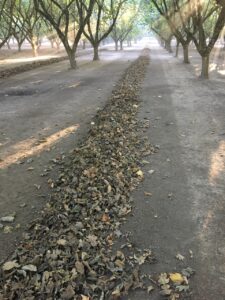
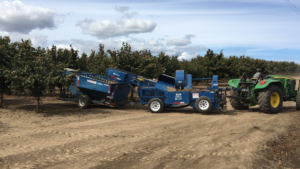
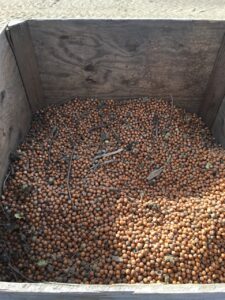
- Select candidate cover crop species with producer input.
- Lay out cover crop research plots in mature orchards.
- Coordinate seed purchase and seed drill rental.
- Seed 1 acre of each of 4 seed treatments and controls (unseeded, bare ground) into replicated test plots in randomized block design at each cooperating producer orchard.
- Evaluate fall seeded winter cover crop germination and establishment and for green manure crops, evaluate the amount of plant available N (PAN) produced.
- Evaluate biomass production and percent cover produced by seeding cover crops in spring vs. summer.
Cooperators
- (Educator and Researcher)
- (Educator and Researcher)
- (Educator and Researcher)
Research
Objective 1. Select candidate cover crops with producer input.
In selecting our candidate cover crops we reached out to multiple specialty seed producers in the Willamette Valley to solicit opinions and knowledge. We also met with the USDA-NRCS Plant Materials Center in Corvallis, OR and attended their field days.
We held a cover crop workshop and grower panel at the Oregon State University North Willamette Research and Extension Center (NWREC) in Aurora on June 2, 2016 (Fig. 1). The workshop attracted approximately 35 growers. In the workshop we had presentations from representatives of both the Clackamas and Yamhill County Soil and Water Conservation Districts (SWCDs), who discussed cover crop options for hazelnut orchards and how cover crop plantings could fit in with NRCS conservation incentive programs (EQIP). We also had a grower panel where growers discussed their experience with different cover crops in orchards.

In 2016, the final cover crop selections were determined at a separate planning meeting with the producers cooperating on this grant. We utilized the knowledge that came out of the workshop to make preliminary cover crop selections. Based on grower input, we selected the following cover crops for the first year: subterranean clover (28 lbs/acre), white clover (15 lbs/acre), creeping red fescue (35 lbs/acre), and an annual mix consisting of phacelia (15%), vetch (15%) and triticale (50%; 83 lbs/acre). All cover crops were locally sourced. The untreated control blocks were not seeded but volunteer cover crops may be present (mainly Poa spp.).
In 2017, we consulted with various cover crop and turf seed growers, and the OSU turfgrass Extension specialist to identify additional crops and varieties that may be suitable for an orchard system. Cover crops that were trialed in postharvest and spring seeded plots in 2017 included several varieties of hard fescue, bentgrass, and Kentucky bluegrass, and balansa, berseem, and strawberry clovers. We hoped to evaluate mechanized harvest of nuts over grasses, but growers preferred to terminate the cover crops in anticipation of harvest.
In 2018, we conducted a field day
Objective 2. Coordinate seed purchase and seed drill rental.
Yamhill County Soil and Water Conservation District (SWCD) has become a partner in our project as a way to promote conservation practices. Hazelnuts are one of the top agricultural industries in Yamhill County. Our project precipitated the purchase of a Land Pride 606 NT seed drill (http://www.landpride.com/products/73/606nt-compact-drills )(Fig. 2) by Yamhill SWCD. This seeder was made available for us and for growers to rent. Sam Sweeny, Gordon Cook and Marie Vicksta were key cooperators from the Yamhill County SWCD. Gordon Cook has helped us seed our plots and has invested considerable time in the project.
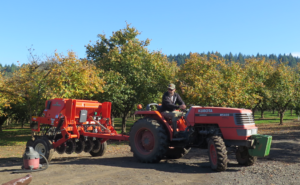
Fig. 2 Land Pride 606 NT seed drill being pulled by OSU faculty research assistant Aaron Heinrich at one of the farmer cooperator sites.
We also contributed to the purchase of a Schmeiser seed drill with other faculty at the Oregon State University North Willamette Research and Extension Center, which we used to seed some plots in 2018 and we will use for future cover crop research for hazelnuts. The purchase of the drill was funded by private donations.
Objective 3. Establish replicated research plots at each cooperating producer orchard.
We used a randomized complete block design with three replicates to plant cover crop blocks at each orchard. Orchards had tree and alley spacings from 9 ´18 ft (double density) to 20 ´ 20 ft (single density), and each plot was 100 x 6 ft. In all cases we planted the treatments on both sides of the trees (two alleys), and left two unplanted rows between adjacent treatments as a buffer (Fig. 3).
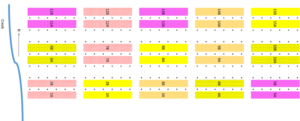
In the fall of 2017, we had much more favorable conditions. All four commercial orchards were seeded between 10/25 and 11/1. Based on cover crop performance in 2016-17 and grower input, subclover and the annual mix were excluded from replicated trials. The treatments in the 2017-18 replicated trials included are listed in Table 1.
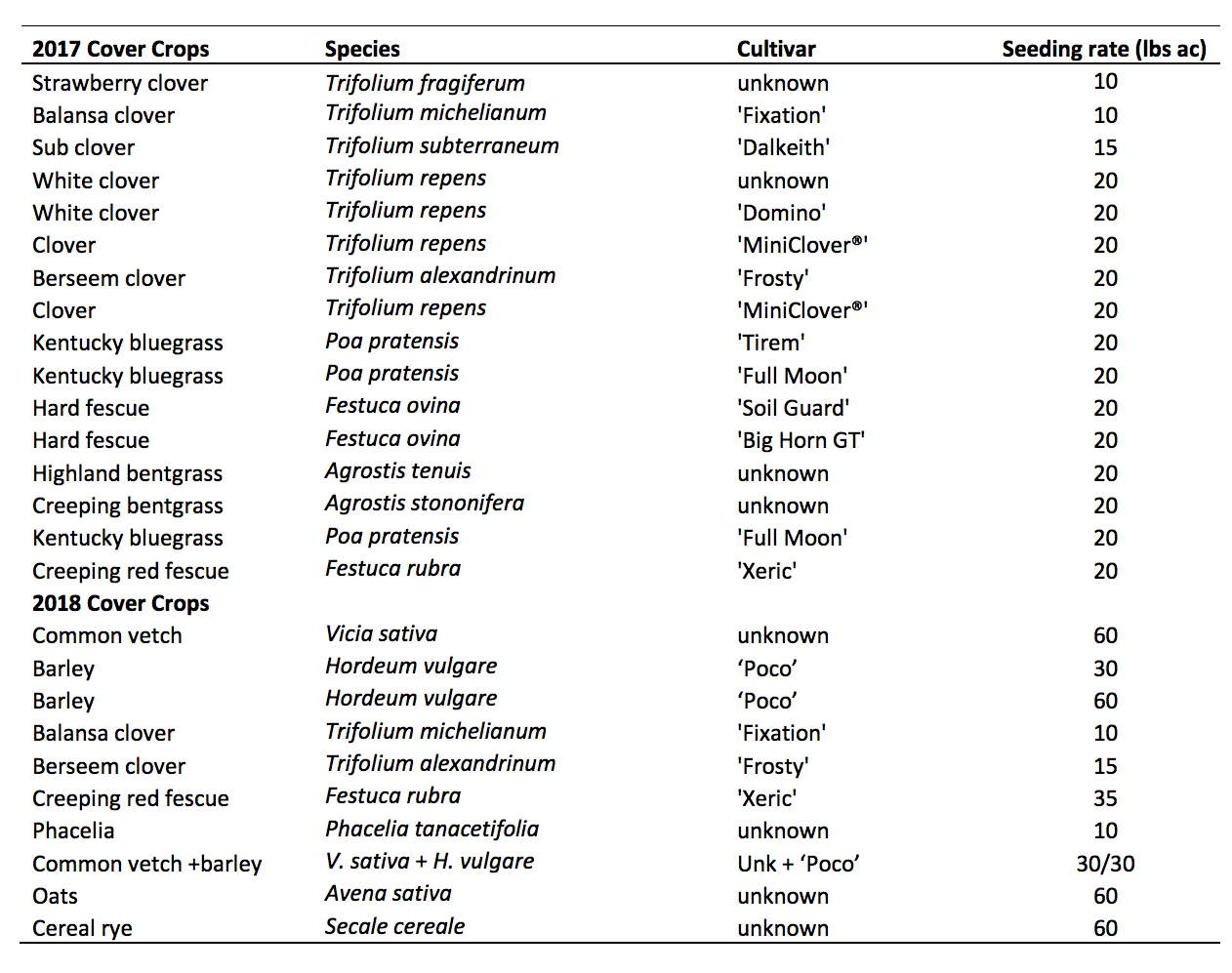
To avoid the issue of weed competition as experienced the previous year, we sprayed out the plots with glyphosate before seeding. At one site, we also seeded a single, unreplicated 600-ft strip of various cover crops. Most orchards have a volunteer cover crop that begins growing after harvest and the fall rains begin. Unfortunately, at most sites the plant species present in the volunteer cover crop are shallow rooted weeds that cannot contribute much to winter soil conservation.
Objective 4. Monitor cover crop growth, productivity and nitrogen fixation
In 2016 and 2017, cover crop plots were assessed for germination and percent cover every six weeks following planting. Percent cover was assessed within a 1/2m quadrat that was randomly placed within each of the test plots in all years at maximum standing crop.
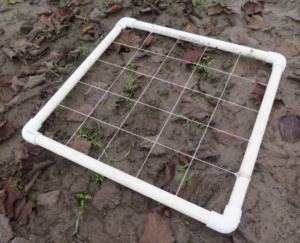
In 2017 and 2018, we collected biomass and N uptake data for the annual cover crop mix (triticale, vetch and phacelia) at maximum standing crop. This was done by clipping the vegetation in quadrat from 2-3 random locations in the plot. Biomass was weighed fresh and after being dried in a plant dryer (Sheldon Manufacturing, Inc., Cornelius, OR). Plant samples were sent to Brookside Laboratories () for analysis of % N. We used the calculations in the Oregon State University Cover Crop Calculator to estimate the total amount of nitrogen fixed by green manure crops.
In 2018 we also seeded some of our candidate cover crops in plots at the Oregon State University Tree Fruit Research and Extension Center at Aurora OR in between our (younger) hazelnut plots. We did this to compare productivity of the cover crops in orchards with a full canopy and orchards with smaller canopy volume. Crops seeded in fall of 2018 were evaluated in spring of 2019.
The fall/winter of 2016-17 was a challenging year for establishing winter cover crops throughout the Willamette Valley. We planned on seeding cover crops immediately after harvest but the weather was not cooperative. October was the second wettest in history, with 10-11 inches of measured precipitation at locations near the producer orchards. Wet and muddy conditions delayed planting of cover crops until mid-November. Due to wet, cold soil conditions and low light intensity, germination and growth was poor for all cover crops. In early January of 2017, we experienced several weeks below freezing temperatures with significant snow accumulation in some locations.
Germination of treatments was successful at most sites, but following an extremely cold spell in January, many plants died. In the winter, the cover crop was too small to effectively minimize erosion, but by the spring would be effective (Fig. 5). At several sites, the seedlings that were not killed by the cold were killed by slugs. Also, significant weed competition at some sites hindered establishment and growth. The relatively large seed size of the annual mix compared to the perennial crops tested likely helped the annual cover crop establish. At the final check in May 2017, the flowering annual mix was performing extremely well (Fig. 6). All previously seeded cover crop plots are followed in subsequent years. The annual mix was allowed to reach maximum standing crop in 2017 (Fig. 7), and we have noted that the vetch successfully reseeded itself for 2018.
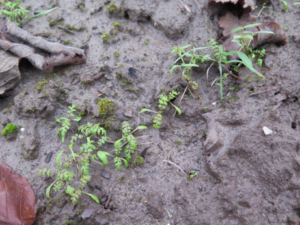
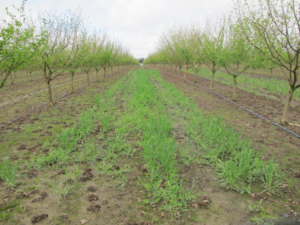
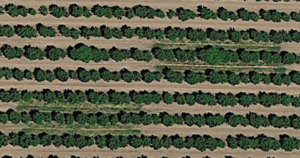
No cover crops seeded postharvest provided adequate cover on the orchard floor during the winter (Fig. 8). Early in the growing season the amount of cover increased, but this was too late to contribute to a reduction in erosion (Fig. 9).
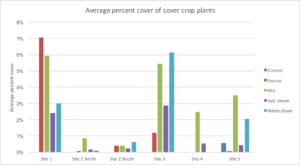
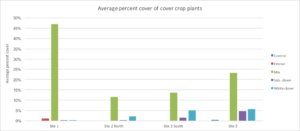
The annual mix represented our most successful treatment from 2017 and it produced enough biomass during the growing season to make a substantial contribution to the N budget of the orchard (Fig. 10). At three of the sites, N uptake was approximately 20 lbs/acre, but at Site 1, it was 60 lb/acre. At Site 1, N uptake was high enough to offset spring fertilizer applications, which are typically around 100 lb N per acre depending on tree size (Fig. 11). This assumes that the cover crop is flailed and sufficient moisture is available to break down plant residues and release the nutrients to the hazelnut trees.
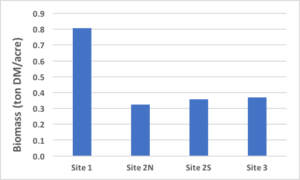
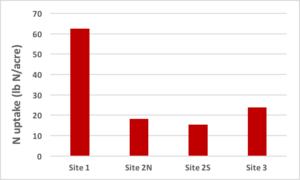
Of the green manure cops we selected to seed in fall of 2017 only Berseem, White and Balansa Clover established enough to evaluate. Berseem (Egyptian) clover is purported to tolerate wet ground well but has limited winter hardiness. White clover was selected because we noted that it was the only clover that was tolerant of a full season of orchard floor management and was resistant to herbicide management. For this reason, we do not see white clover as a potential cover for orchards where it may become a persistent weed. Balansa clover is known for its robust rooting which could be very beneficial in hazelnut orchards. One advantage of this clover is that it can be seeded at low rates (we looked at 10 lb/Ac). Berseem and white clover both contributed a substantial amount of N (Fig. 12) and are worth further exploration.
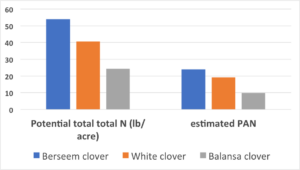
One of the most difficult challenges we faced was getting cover crops established after harvest. This was particularly true of some of the grasses, such as creeping red fescue (Fig. 13). A few growers are using permanent cover with red fescue, but it is clear that it does not establish well over the winter and so results here should not be misinterpreted. There are other seeding techniques and better times to seed that could greatly improve establishment. Of the grasses we trialed (oats, rye, barley and fescue), the oats most easily established and provided the most cover and are a good choice for a fall seeded anti-erosion cover crop in orchard alleys. It was also the case that the oats provided the most cover at the cooperator orchard (Fig. 14), even though this orchard was planted later and has a very mature tree canopy (Fig. 15). The downside of these grasses was the level of biomass produced (Figs. 16, 17)
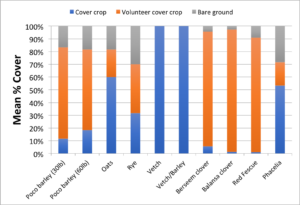
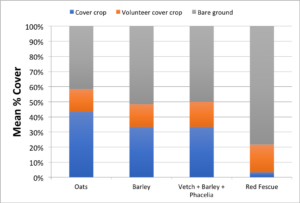
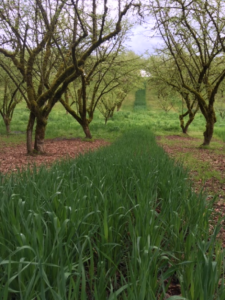
Confirming prior experience, the vetch (Fig. 19) provided excellent coverage and did not need a companion plant to achieve this, as mixing barley with the vetch seed provided no additional benefit for coverage and interfered with the N-fixing capacity, which was a substantial amount for the pure stands, but lower for the mix (Fig. 18). We noted that vetch also was one of the few annual cover crops that that successfully regenerated itself the following year in plots that were not reseeded, which we attributed to hard seed. Vetch also had much lower biomass compared to grasses and may be expected to break down more effectively after termination. Other crops like the Balansa and Berseem clover had difficulty competing with the volunteer cover crop and did not establish well (Fig. 13).
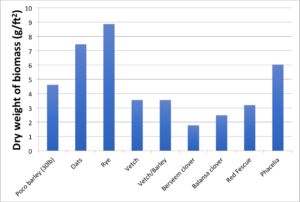
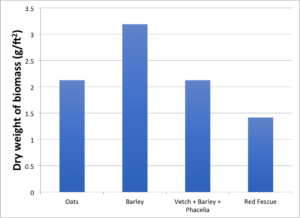
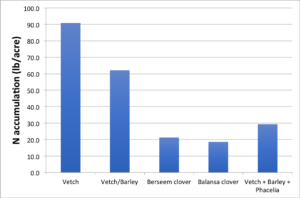
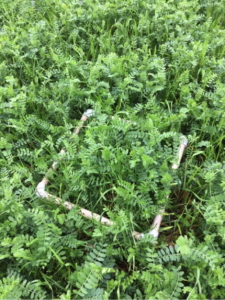
Finally, the Phacelia cover crop also provided excellent cover (Fig. 13) and was perhaps the most valuable plant to pollinators that we examined. It provided the best cover when seeded as a pure stand but it also worked well in the mixes. We have noted from plots seeded with Phacelia in previous years that the crop often regenerates from seed. We noted incredible diversity of bee species utilizing the Phacelia cover crops we planted and while this is a benefit to pollinator conservation, it would be important to avoid use of most pesticides during the flowering period.
Research Outcomes
Education and Outreach
Participation Summary:
The main educational activities were the initial cover crop workshop, the on-farm trials (at 5 different farms), and the cover crop field day that we co-organized with Yamhill County SWCD on May 29, 2018. We had about 35 growers at that event, plus additional representatives from from NRCS and SWCDs from around the Willamette Valley. We also promoted the project on Facebook (@OSUHazelnutExtension) where we routinely reach 1,000 + people per post. There were also other informal interactions and consultations in the field as PI Wiman makes 30-40 farm visits per growing season. More information exchange took place on a tour arranged by Marion County SWCD to observe erosion mitigation projects for hazelnut orchards including a visit to a farm that has adopted permanent grass cover (fine fescue) and was successfully harvesting over the cover crop. PI Wiman was also a speaker at the Organic Hazelnut Grower Field Tour where WSARE project results were disseminated to about 60 growers. PI Wiman also had the opportunity speak about the WSARE project and address municipal water utilities that draw water from the Willamette River at a meeting of the Willamette Future Project (approx. 30 people). Many municipalities are concerned about increasing hazelnut acreage and orchard floor management leading to increased water pollution. We plan to produce an Extension document as a culmination of this WSARE project where we will discuss application of cover crops to hazelnut orchards for N fixation and soil health, erosion mitigation, and if we can find additional funding we would ultimately like to evaluate hazelnut harvest over different cover crops and also determine how much cover crops compete with trees for soil moisture.
Education and Outreach Outcomes
At the time we developed our proposal we knew that we were addressing an important problem, but we were unaware of how difficult it would be to establish the cover crops in mature orchard alleys and it was unrealistic to expect adequate germination, growth, and erosion prevention from a postharvest fall-seeded cover crop with rare exceptions. However, we have learned a lot about the hazelnut orchard floor management system and would change our approach in future projects. As hazelnut acreage continues to expand, the problem of soil, nutrient, and pesticide loss from orchards will continue to increase in the Willamette Valley, where there are now close to 80,000 acres of hazelnuts.
As we progressed, it became clear that growers need cover crops for different reasons. For organic growers, N-fixing cover crops are likely the most affordable and sustainable source of N to meet needs of hazelnut trees. We found that vetch in particular, but also other green manure crops can contribute substantial N to the orchard trees and green manure crops do represent a viable alternative to off-site N sources for organic growers. However, in the conventional system, Urea is applied in the early spring for the most effective uptake by trees during the growing season. Future studies on green manure crops in hazelnut orchards should focus on the delivery of the N to the trees, perhaps exploring a "mow and blow" approach to depositing the cover crop residue on the tree rows. Future studies should also examine timing of the termination of the N-fixing cover crop to maximized uptake by orchard trees.
Then there are the erosion and harvest considerations. For sloped orchards in particular, the demands for the cover crop are to provide a surface that allows nut harvest on soils that would otherwise be too muddy or slippery to harvest during a wet year, and to grow quickly during winter in order to prevent soil loss. In both systems however, we need to look at ways to 1) maintain and regenerate the cover crop and determine its effect on irrigation need and other production practices, and 2) evaluate costs and efficiency of maintaining and regenerating the cover crop annually, and 3) evaluate the quality of nuts harvested over cover crops like fine fescues. New harvester technology is one important component of the system that needs to be examined. For example, with over-tree harvest technology, there is no need to maintain bare orchard floor for harvest. Tree shaking has been attempted but hazelnuts tolerate shaking poorly. Even more traditional harvest technology is improving, and some grower have found success harvesting over flailed grass cover crops with modern orchard floor harvest systems.
A final suggestion for future research is to involve hazelnut processors in the field research and Extension efforts. Hazelnut receiving stations and processors promote clean orchard floor practices with their growers because they have to deal with the debris that comes in with the nuts at harvest. Cleaning debris from nuts is a bottleneck in hazelnut processing that can greatly affect efficiency. Grass thatch, rocks, dirt clods, mud and woody debris are all contaminants that affect performance of processing machinery. The costs of cleaning harvested nuts are passed on to the grower as dockage. If harvest practices are demonstrated to be compatible with cover crops without increasing cleaning dockage, nut receiving stations and processors would be critical promoting change to orchard floor practices.
Improved knowledge of challenges for establishing cover crops in hazelnut orchards.
Improved knowledge of how much plant available nitrogen (PAN) can be expected out of an orchard with N-fixing cover crop planted in the alleys.
The project provided baseline data on cover crop selections for the hazelnut orchards in the Willamette Valley.